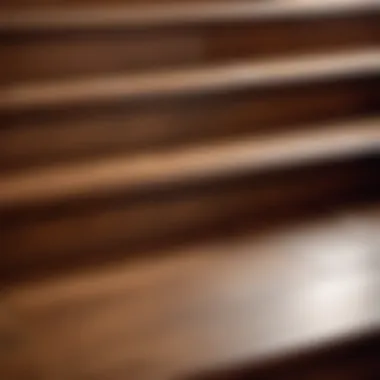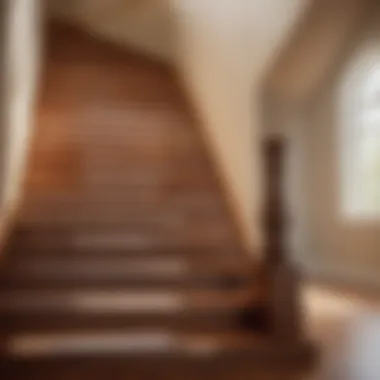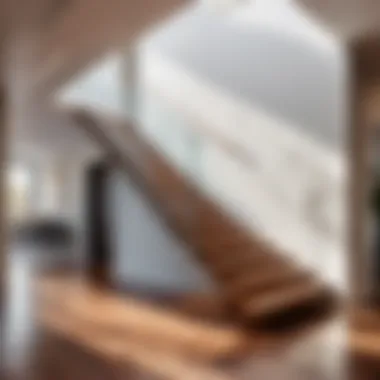Materials:
When embarking on the project of installing engineered hardwood on stairs, it is crucial to have all the necessary materials readily available. These materials will ensure a smooth and successful process without any interruptions or delays. Here is a detailed list of the materials required:
-
Engineered Hardwood Flooring: Measure the dimensions of your stairs carefully to determine the quantity of engineered hardwood flooring needed. Opt for high-quality flooring to achieve a durable and aesthetically pleasing result.
-
Adhesive: Select a premium adhesive specifically recommended for engineered hardwood to ensure strong and long-lasting adhesion to the stairs.
-
Underlayment: Use underlayment to provide a moisture barrier and sound absorption for a quieter and more comfortable tread underfoot.
-
Nails or Staples: Depending on the installation method chosen, prepare either nails or staples to secure the engineered hardwood to the stairs securely.
-
Saw: A saw is essential for cutting the engineered hardwood planks to fit the dimensions of each stair tread accurately.
-
Measuring Tape: Accurate measurements are key to a precise fit, so a measuring tape is indispensable for this project.
-
Safety Gear: Prioritize safety by wearing appropriate gear such as goggles and gloves to protect yourself during installation.
-
Sanding Tools: Prepare sanding tools to smooth out any rough edges or imperfections on the engineered hardwood for a polished finish.
-
Finishing Products: Consider options for finishing products such as stains or sealants to enhance the appearance and durability of the hardwood.
DIY Steps:
Once all the materials are gathered, it's time to delve into the step-by-step process of installing engineered hardwood on stairs. Follow these detailed instructions carefully for a successful outcome:
-
Prepare the Stairs: Clear the stairs of any obstructions and ensure they are clean and smooth before starting the installation.
-
Cutting and Fitting: Measure each stair tread precisely and cut the engineered hardwood planks to fit. Remember to leave expansion gaps on each side for seasonal changes.
-
Adhesive Application: Apply the recommended adhesive to the stair treads following the manufacturer's instructions to guarantee a secure bond.
-
Securing the Hardwood: Carefully place each cut plank onto the adhesive, pressing firmly to ensure proper adhesion. Use nails or staples to further secure the planks if necessary.
-
Finishing Touches: Sand the edges and surfaces of the hardwood to achieve a seamless look. Apply finishing products to protect the hardwood and enhance its appearance.
Technical Aspects:
In addition to the materials and DIY steps, understanding the technical aspects of installing engineered hardwood on stairs is essential for a successful project:
-
Timing: Allocate sufficient time for each step of the installation process to ensure precision and quality craftsmanship.
-
Tools: Utilize tools such as a saw, measuring tape, and sanding tools to facilitate the installation process and achieve professional results.
-
Techniques: Implement proper cutting and fitting techniques, adhesive application, and finishing methods to enhance the quality and uniqueness of the project.
-
Safety Measures: Prioritize safety by wearing appropriate gear and following safety guidelines throughout the installation process.
DIY Project Process:


By following the sequential steps outlined above, you can successfully install engineered hardwood on stairs. Remember to pay attention to key techniques, timings, and troubleshooting tips to address any challenges that may arise:
-
Key Techniques: Ensure precise cutting, proper adhesive application, and secure fitting techniques for a seamless and durable installation.
-
Timings: Plan each step of the process carefully, allowing adequate time for drying, finishing, and any adjustments required.
-
Troubleshooting Tips: Be prepared to address common mistakes such as misalignments or adhesive application errors promptly to prevent issues and ensure a flawless result.
Introduction


In the realm of home improvement projects, the process of installing engineered hardwood on stairs emerges as a crucial topic that warrants thorough exploration. This section serves as the foundational platform to delve deeper into the intricate details and considerations involved in this specific undertaking. Understanding the nuances of this project is essential for homeowners looking to enhance the aesthetic appeal and functionality of their living spaces. From the selection of materials to the skillful execution of labor, every aspect of this installation plays a vital role in defining the overall outcome.
Understanding Engineered Hardwood
The realm of engineered hardwood unveils a versatile and durable flooring option that has gained immense popularity in recent times. Unlike solid hardwood, engineered hardwood comprises multiple layers, with a top layer of real wood bonded to high-quality plywood or fiberboard. This innovative construction offers greater stability, making it an ideal choice for various surfaces, including stairs. Homeowners opting for engineered hardwood can enjoy the aesthetic beauty of authentic wood flooring without compromising on durability or functionality.
Importance of Stairs Installation
Stairs hold a unique position within a home, serving as both a functional and design element. When it comes to installing engineered hardwood on stairs, the importance of this process transcends mere visual enhancement. It involves creating a seamless transition between different floors, enhancing the overall flow and cohesiveness of the living space. Opting for hardwood on stairs not only elevates the aesthetic appeal but also contributes to the longevity and durability of the staircase. The installation of engineered hardwood introduces a sense of sophistication and elegance to the interior, adding value to the entire property.
Factors Affecting Costs


When delving into the realm of installing engineered hardwood on stairs, understanding the various factors influencing costs is paramount. By comprehending the intricate details that impact the overall expenses, homeowners can effectively plan and budget for this home improvement project.
Material Selection
Choosing the right material for engineered hardwood on stairs is a crucial decision that significantly affects the overall cost. Factors such as the quality, species, and brand of the engineered hardwood can all contribute to varying price points. Additionally, the finish and texture of the material can also influence the cost, with premium finishes commanding higher prices. It is essential for homeowners to weigh the aesthetic appeal and durability of the material against their budget constraints to make an informed choice.
Staircase Design Complexity
The design complexity of the staircase plays a pivotal role in determining the installation cost of engineered hardwood. Factors such as the number of steps, angles, curves, and turns in the staircase can increase the labor and material requirements, thus affecting overall expenses. Straight, simple staircases are typically more cost-effective to install compared to intricate designs that demand precision cutting and fitting. Homeowners should consider the architectural intricacies of their staircase when estimating the total cost of the project.
Labor Costs
Labor costs constitute a significant portion of the total expenses involved in installing engineered hardwood on stairs. The expertise and skill required for cutting, fitting, and installing the material accurately contribute to the overall labor charges. Additionally, factors such as the time taken to complete the project, labor rates in the region, and any specialized equipment needed can impact the final labor costs. Homeowners should research and compare labor quotations from reputable professionals to ensure they are getting fair pricing for the installation work.
Calculating Costs
When it comes to installing engineered hardwood on stairs, calculating costs plays a crucial role in budget planning and project management. Understanding the expenses involved allows for a more accurate estimation of the overall investment required. By breaking down the costs into various components, homeowners can make informed decisions and avoid unexpected financial surprises along the way.
Calculating costs encompasses a range of specific elements that contribute to the overall expenditure of the project. These elements include material costs, labor fees, additional expenses, and any unforeseen contingencies. By analyzing each of these factors meticulously, individuals can create a comprehensive budget that covers all aspects of the installation process.
The benefits of thorough cost calculation are manifold. Firstly, it helps in setting realistic budget expectations, ensuring that the project stays within financial boundaries. Secondly, it allows for effective cost management, enabling homeowners to allocate funds wisely across different aspects of the installation. Lastly, accurate cost calculation leads to better decision-making, as individuals can choose materials and services that align with their budget constraints and quality preferences.
When considering costs for installing engineered hardwood on stairs, there are several key considerations to keep in mind. Factors such as the type of hardwood selected, the complexity of the staircase design, and the expertise of the labor force can all impact the overall expenses. By diving deep into the calculations, homeowners can gain a clear understanding of where their money is going and make informed choices that suit their financial capabilities.
Square Footage of Stairs
The square footage of stairs is a fundamental aspect to consider when estimating the cost of installing engineered hardwood. This measurement serves as the basis for determining how much material will be needed to cover the stairs adequately. Calculating the square footage involves taking precise measurements of each stair tread and riser to ensure accurate coverage without unnecessary waste.
In the context of engineered hardwood installation, the square footage of stairs directly influences the material costs involved. The larger the staircase area, the more material will be required, leading to increased expenses. Additionally, irregular stair shapes or sizes can impact the square footage calculations, requiring careful adjustments to account for any unique features that may affect the installation process.
To calculate the square footage of stairs, homeowners must measure the length and width of each tread and riser, accounting for any nosing or overhang present. By multiplying the length by the width of each step and summing up all individual measurements, they can arrive at the total square footage needed for the project. This meticulous approach to measurement ensures that the right amount of material is purchased, avoiding both shortages and excess waste.
Additional Expenses
Aside from material and labor costs, there are various additional expenses to consider when installing engineered hardwood on stairs. These supplementary charges can arise from factors such as delivery fees for materials, equipment rentals, permits, and temporary storage solutions.
Delivery fees are common when purchasing large quantities of hardwood flooring, especially if the supplier is located far from the installation site. Homeowners should factor in these costs when budgeting for the project to avoid last-minute surprises. Equipment rentals, such as saws, nail guns, and measuring tools, may also incur additional expenses if homeowners do not own these specialized items.
Permit costs are another financial consideration, as some regions require permits for extensive home remodeling projects like staircase installations. Checking with local authorities and obtaining necessary permits in advance can prevent costly fines or delays. Lastly, temporary storage solutions for furniture or household items during the installation process may necessitate rental fees, especially for longer projects.
By accounting for these additional expenses in the overall budget, homeowners can better prepare for the financial outlay required to complete the engineered hardwood stair installation efficiently and smoothly.
Cost Breakdown
When considering the installation of engineered hardwood on stairs, understanding the cost breakdown is crucial. A detailed analysis of expenses not only ensures you stay within budget but also helps in making informed decisions regarding material selection and labor costs. By breaking down the overall expenses, you can allocate funds appropriately to different aspects of the project.
Material Costs
Material costs play a significant role in the overall budget for installing engineered hardwood on stairs. The type and quality of the engineered hardwood chosen will directly impact the cost. High-quality materials may come at a higher price but offer greater durability and aesthetic appeal. Additional factors such as the quantity needed to cover the staircase and any special finishes or coatings will also add to the material costs. It is essential to consider both the upfront expenses and the long-term benefits when selecting the materials for your project.
Labor Costs
Additional Considerations
Warranty and maintenance costs also play a significant role in the overall expenses of installing engineered hardwood on stairs. While selecting materials, it is essential to inquire about warranties offered by manufacturers. Warranty coverage can safeguard your investment and provide peace of mind in case of any defects or issues post-installation. Additionally, factoring in maintenance costs for engineered hardwood helps to anticipate future expenditures and plan accordingly to preserve the longevity and aesthetics of the stairs.
Overall, these additional considerations are essential to making informed decisions regarding the cost of installing engineered hardwood on stairs, ensuring a successful and budget-conscious home improvement project.
DIY vs. Professional Installation
In the realm of installing engineered hardwood on stairs, the choice between tackling the project yourself or hiring professionals is pivotal. DIY installation may appear enticing due to perceived cost savings, but it comes with its own set of challenges. Without the expertise and tools that professionals possess, errors in measurement, cutting, or installation can occur, leading to potential material wastage and the need for costly remedies. Moreover, DIY projects often take longer to complete, causing inconvenience and disruption.
Contrastingly, opting for professional installation offers numerous benefits. Professionals bring years of experience and specialized knowledge, ensuring precision and efficient completion of the project. While the initial cost may be higher than a DIY approach, the quality of workmanship and time saved can outweigh the extra expense. Additionally, professionals may have access to premium materials not readily available to consumers, enhancing the overall aesthetics and durability of the engineered hardwood stairs.
Understanding your skill level, time constraints, and budget is crucial when deciding between a DIY or professional installation for engineered hardwood stairs, ultimately impacting the overall cost and outcome of the project.
Warranty and Maintenance Costs
The financial aspect of installing engineered hardwood on stairs extends beyond the initial expenses, encompassing warranty and maintenance considerations. Prior to making purchasing decisions, investigating the warranties provided by manufacturers is imperative. Warranties vary in coverage, duration, and terms, influencing the overall value and protection they offer for your investment.
Moreover, accounting for maintenance costs is essential to uphold the beauty and condition of the engineered hardwood stairs over time. From routine cleaning to occasional repairs or refinishing, budgeting for maintenance ensures the longevity and aesthetic appeal of the stairs. By proactively addressing maintenance needs, homeowners can prevent costly damage and preserve the quality of the installation.
Conclusion
Final Thoughts
Wrapping up the discussion on the cost of installing engineered hardwood on stairs, it becomes evident that meticulous planning and budgeting are key to a successful outcome. Ensuring clarity on material prices, labor costs, and other expenses is essential for avoiding budget overruns and project delays. Homeowners should carefully assess their requirements and preferences to make informed choices that align with their budget constraints and aesthetic goals. By weighing the benefits of different installation approaches and factoring in long-term warranty and maintenance expenses, individuals can make educated decisions that lead to a satisfactory and durable hardwood staircase. Ultimately, attention to detail, careful consideration of costs, and strategic planning are vital components for achieving a seamless and cost-effective engineered hardwood stair installation.





